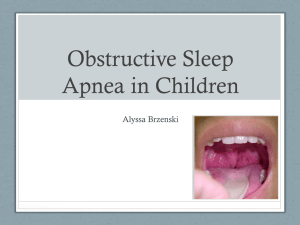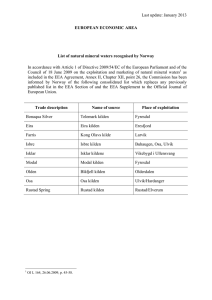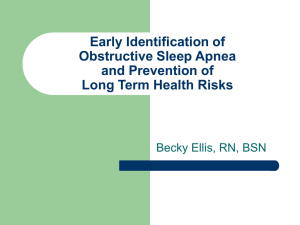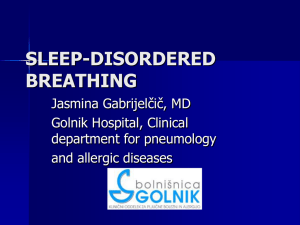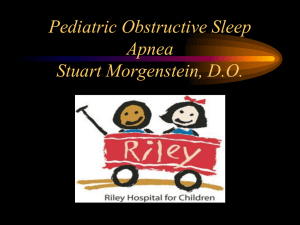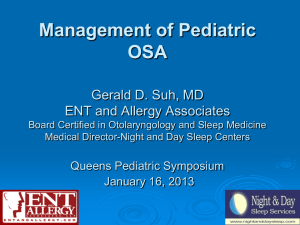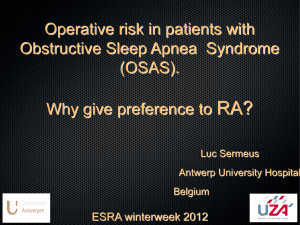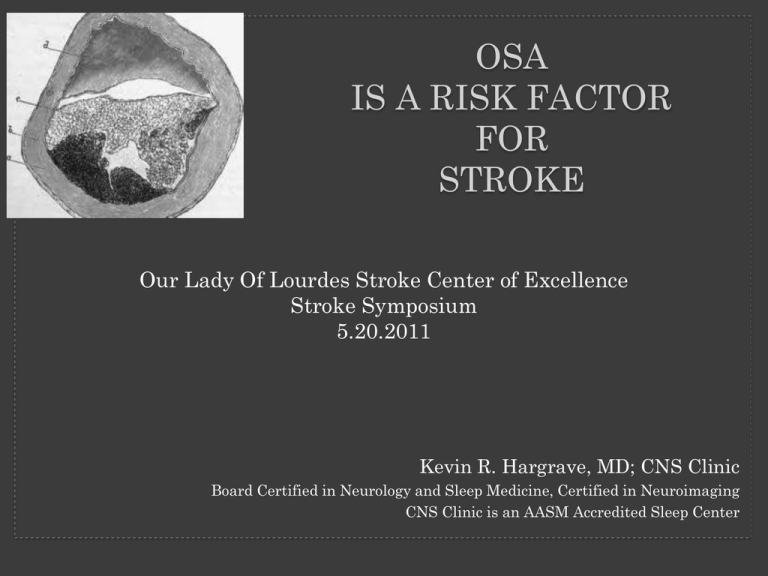
OSA
IS A RISK FACTOR
FOR
STROKE
Our Lady Of Lourdes Stroke Center of Excellence
Stroke Symposium
5.20.2011
Kevin R. Hargrave, MD; CNS Clinic
Board Certified in Neurology and Sleep Medicine, Certified in Neuroimaging
CNS Clinic is an AASM Accredited Sleep Center
OSA is a risk factor for Stroke
Kevin R. Hargrave, MD; CNS Clinic
Our Lady Of Lourdes Stroke Center of Excellence
2
TOPICS, OBJECTIVES
• CVA: definitions, mechanisms
• OSA: definition, epidemiology
• Expert Consensus Document from J Amer College of Cardiology
• JCSM article
• Risks factors for CVA which OSA causes or exacerbates
– HTN
– Hypertension
– Diabetes
– Dyslipidemia
– Carotid stenosis
– Atrial fibrillation
– CHF/cardiomyopathy
– Hypercoagulability/inflammation/endothelial dysfunction
– Smoking
• OSA treatment improves some of the above
CLASSIFICATION
BY
MECHANISM
Cryptogenic
Cardio or aorto-embolic
Carotid stenosis
Intracranial large artery stenosis
Lacunar/
small artery atherosclerosis
4
Types of Stroke
15%
85%
Primary
Hemorrhage
Transient Ischemic
Ischemic Stroke
Attack
Atherosclerotic
Disease
20%
Intraparenchymal Subarachnoid
Hemorrhage
Hemorrhage
Lacunar
(Small Vessel) 25%
Other/Unknown
35%
Cardioembolism
20%
5
Partial and complete airway obstruction resulting in hypopnea and apnea, respectively
Somers, V. K. et al. J Am Coll Cardiol 2008;52:686-717
Copyright ©2008 American College of Cardiology Foundation. Restrictions may apply.
Stroke; cerebral infarct
(CVA)
Modifiable Risk Factors:
Hypertension
Diabetes
Dyslipidemia
Carotid stenosis
Atrial fibrillation
CHF
Hypercoagulability
Smoking
Endothelial dysfunction
OSA
OSA is an independent risk factor for stroke
TIA or stroke patients should be screened for OSA
Conversely, stroke can cause or exacerbate OSA
Treating OSA can prevent further strokes or other vascular events
Obstructive Sleep Apnea
(OSA)
Stroke; cerebral infarct
(CVA)
exacerbates:
Hypertension( )
Diabetes ( )
Dyslipidemia ( )
Carotid stenosis ( )
Modifiable Risk Factors:
Hypertension
Diabetes
Dyslipidemia
Carotid stenosis
Atrial fibrillation ( )
CHF( )
Hypercoagulability
Atrial fibrillation
CHF
Hypercoagulability
*Smoking
Smoking
OSA
OSA is an independent risk factor for stroke
TIA or stroke patients should be screened for OSA
Conversely, stroke can cause or exacerbate OSA
Treating OSA can prevent further strokes or other vascular events
(CVA)
Nonmodifiable Risk Factors:
Family history
Age
Ethnicity
(CVA)
Nonmodifiable Risk Factors:
Family history
Age
Ethnicity
Treating your apnea will not
relieve you of your family history,
make you younger
or make you tall dark or handsome…
(but you might feel younger and more attractive and you may be able to tolerate your
family better)
PREVALENCE
VS
AWARENESS
• % of pop w d.o.
• HTN:
• DM:
• Afib:
> 30%
8%
4-8%
» (4% over 60yo; 8% over 80yo)
• OSA
10-20%
http://emedicine.medscape.com
PREVALENCE
• % of pop w d.o.
VS
AWARENESS
% aware they have d.o.
(ideally 100%)
• HTN:
• DM:
• Afib:
> 30%
8%
**
70%
<70%
<60%
• OSA
10-20%
18%
http://content.onlinejacc.org/cgi/content/full/52/8/686
Over 400 references
OSA affects an estimated 15 million adult Americans
and is present in a large proportion of patients with
hypertension and in those with other cardiovascular
disorders, including
• coronary artery disease,
• stroke, and
• atrial fibrillation (1–14).
However,
>85% of patients with clinically significant and treatable
OSA have never been diagnosed,
and referral populations of OSA patients represent only
the "tip of the iceberg" of OSA prevalence (42,43)
Schematic outlining proposed pathophysiological components of OSA, activation of
cardiovascular disease mechanisms, and consequent development of established
cardiovascular disease
Somers, V. K. et al. J Am Coll Cardiol 2008;52:686-717
Copyright ©2008 American College of Cardiology Foundation. Restrictions may apply.
• A blunted nocturnal BP decline has been associated with
greater leukoaraiosis (white matter disease) (134).
• In a cross-sectional study of Japanese men, brain MRI
revealed silent brain infarction in
– 25% of patients with moderate to severe OSA
– 8% of patients with mild OSA
– 6% of control subjects,
suggesting that OSA may elicit early and asymptomatic
cerebrovascular damage (88)
• patients with drug-resistant HTN, defined as a BP of
140/90 mm Hg on 3 BP meds, Logan et al noted the
prevalence of OSA (AHI >10), was 83% (145).
• The weight of evidence has led the most recent Joint
National Committee on the Detection and
Management of Hypertension to identify OSA as an
important identifiable cause of hypertension (149).
Recent 10-year follow-up data of patients with stroke
show
an increased risk of death in those patients with OSA
(adj OR, 1.76)
that is independent of age, sex, BMI, smoking,
hypertension, diabetes mellitus, atrial fibrillation,
Mini-Mental State Examination Score, and Barthel
Index.
Treatment Options in OSA.
Obesity is the single most important cause of
OSA.
Weight loss can lead to a decrease in AHI,
improved sleep efficiency, decreased snoring,
and improved oxygenation.
The most dramatic results have been reported
with surgical weight loss (312–314).
• In addition, apnea often is worse in the supine
posture, with some patients having OSA only in that
position (315,316).
• For patients with "positional apnea," behavioral
techniques aimed at keeping the patient in the lateral
posture during sleep (an uncomfortable object sewn
into the back of the nightshirt or positional alarms)
may offer benefit.
CPAP, applied via a nasal mask, continues to be
the primary therapy for patients with OSA
(59,60).
The device consists of a mask connected to a
blower that maintains positive airway
pressure at the desired level, acting as a
pneumatic splint for the pharyngeal airway
(317,318).
The prescribed CPAP pressure is generally determined
in the sleep laboratory as that pressure required to
eliminate all snoring, apneas, and hypopneas during
all sleep stages and in all body positions.
There is evidence supporting improvements in measures
of OSA, daytime sleepiness, and neurocognitive
function with nasal CPAP (319–324).
Despite the effectiveness of CPAP in treating OSA,
adherence to therapy continues to be a major problem
(325,326).
This relates primarily to the facial interface (mask) and the
pressure required to prevent airway collapse, with some
patients finding CPAP intolerable.
Most evidence suggests that proper introduction of and
education regarding CPAP, in both the sleep
laboratory and the physician's office, are important.
Proper humidification of the inspired air, careful
selection of the appropriate mask, and the addition of
a pressure ramp all may improve compliance.
The use of bilevel positive airway pressure (higher
pressure on inspiration than expiration) or a
constantly adjusting, autotitrating device may
improve patient acceptance.
***
Obstructive Sleep Apnea
(OSA)
exacerbates:
Hypertension
(Bixler, Hoffstein, Jelic, Lavie, Nieto,
Lindbergh, Pancow, Peppard, Suzuki,
Vgontzas, Waller, Wilcox, Young,
Hoffstein,)
Stroke; cerebral infarct
(CVA)
Modifiable Risk Factors:
Hypertension
Diabetes
Dyslipidemia
Carotid stenosis
Atrial fibrillation
CHF
Hypercoagulability
Smoking
OSA
OSA is an independent risk factor for stroke
TIA or stroke patients should be screened for OSA
Conversely, stroke can cause or exacerbate OSA
Treating OSA can prevent further strokes or other vascular events
SLEEP HEART HEALTH STUDY
1995-98; 6,132 pt’s unattended home PSG’s
OR for HTN if OSA present 1.37
(Comparing an AHI of >30 to <1.5)
Similar results seen if use desats <90
HTN and AHI correlated even when BMI, ETOH,
ethnicity, and age are adjusted for, but association
less tight after adjusting for BMI
Nieto et al. (Sleep Heart Health Study) JAMA 2000;283:1829-36
TORONTO STUDY
2,677 pt’s with PSG
Each 1 unit increase in AHI
increased risk of HTN by 1%
Also, for each 10% dec in O2 sat,
inc HTN risk by 13%
Lavie et al. BMJ 2000;320:479-82.
WISCONSIN SLEEP COHORT
•
•
•
•
1993
N=602
OSA: 24% of men, 9% of women
100 publications have stemmed from the WSC
• Nocturnal non-dipping of BP in apneics, with severity
gradation
Hla et al. Sleep 2008
WISCONSIN SLEEP COHORT STUDY
709 pt’s PSG
After 4 yrs OR of HTN 2.89 if had AHI >15
Peppard et al (Wisconsin Sleep Cohort Study) NEJM 2000;342:1378-84
HYPERTENSION
A study of over 16,000 men and women
1,700 of which underwent PSG after screening (sleep lab phase)
mean age 47yo; mean BMI 27
No SDB
SDB
(controls)
OR
1.0
HTN
Snoring only
Mild SDB
Mod –severe
(AHI of 0.0)
(AHI of 1-14.9)
(AHI>,=15)
1.6
2.3
6.8
36-37
47-52
% w/
HTN
25-29
Bixler, et al., Arch Int Med 2000 Aug14/28160;2289-95
51-59
…the findings of this study add further
support to the hypothesis that SDB,
including snoring, is an independent risk
factor for hypertension (HTN)…
Thus a physician should consider the
possibility of HTN whenever any type of
SDB is present and conversely should
consider the possibility of SDB whenever
HTN is present.
Bixler, et al., Arch Int Med 2000 Aug14/28160;2289-95
HYPERTENSION
Snoring and RR of
HTN between 1.3 to 2.0
CAD between 1.3 to 2.0
CVA between 1.6 to 10.3
Waller and Bhopal, Lancet. 1989 Jan 21;1(8630):143-6;
TREATING OSA CAN IMPROVE HTN
•
Suzuki et al. Sleep 1993:16;545-49
•
Hoffstein et al. AM J of Med 1991:91;190-96
•
Duran-Cantolla J, Aizpuru F, Martinez-Null C, Barbe-Illa F. Obstructive sleep apnea/hypopnea and
systemic hypertension. Sleep Med Rev. 2009;13(5):323–31.
•
Giles TL, Lasserson TJ, Smith BJ, White J, Wright J, Cates CJ. Continuous positive airways
pressure for obstructive sleep apnoea in adults. Cochrane Database Syst Rev. 2006;(1):CD001106.
•
Lavie et al. BMJ 2000;320:479-82.
•
Pankow et al. NEJM 2000:343:966.
•
Robinson GV, Smith DM, Langford BA, Davies RJ, Stradling JR. Continuous positive airway
pressure does not reduce blood pressure in nonsleepy hypertensive OSA patients. Eur Respir J.
2006;27(6):1229–35.
•
Faccenda JF, Mackay TW, Boon NA, Douglas NJ. Randomized placebo-controlled trial of continuous
positive airway pressure on blood pressure in the sleep apnea-hypopnea syndrome. Am J Respir Crit
Care Med. 2001;163(2):344–8.
•
Pepperell JC, Ramdassingh-Dow S, Crosthwaite N, et al. Ambulatory blood pressure after
therapeutic and subtherapeutic nasal continuous positive airway pressure for obstructive sleep
apnoea: a randomised parallel trial. Lancet. 2002;359(9302):204–10.
•
Wilcox et al.Sleep 1993;16:539-44
Obstructive Sleep Apnea
infarct
(OSA)
exacerbates:
Hypertension
Diabetes
(Dean, Vgontzas, Martins, Punjabi)
Stroke; cerebral
(CVA)
Modifiable Risk Factors:
Hypertension
Diabetes
Dyslipidemia
Carotid stenosis
Atrial fibrillation
CHF
Hypercoagulability
Smoking
OSA
OSA is an independent risk factor for stroke
TIA or stroke patients should be screened for OSA
Conversely, stroke can cause or exacerbate OSA
Treating OSA can prevent further strokes or other vascular events
OSA and Diabetes
K Hargrave, MD
Louisiana Academy of Sleep Medicine 2009
GLUCOSE DYNAMICS/DIABETES
MELLITUS
• OSA causes leptin and insulin resistance
Journal of Internal Medicine
Volume 254 Issue 1 Page 32 - July 2003
Metabolic disturbances in obesity versus sleep apnoea: the
importance of visceral obesity and insulin resistance
Vgontzas AN, Bixler EO, Chrousos GP
In conclusion, accumulating evidence provides support to
our model of the bi-directional,
feedforward,
pernicious
association between sleep apnea,
sleepiness,
inflammation
and insulin resistance,
all promoting atherosclerosis and cardiovascular disease.
Sleep-disordered breathing and insulin resistance in
middle-aged and overweight men.
Multivariable linear regression analyses revealed that
increasing AHI was associated with worsening insulin
resistance independent of obesity.
Thus, sleep-disordered breathing is a prevalent condition in
mildly obese men and is independently associated with
glucose intolerance and insulin resistance.
Punjabi et al. Am J Respir Crit Care Med. 2002 Mar 1;165(5):677-82.
CPAP not helpful
for DM
West,
Coughlin,
Czupryniak,
Smurra,
Ip,
Stoohs,
Cooper,
Saini,
Thorax 07
Eur Resp J 07
Sleep 05
Sleep Med 01
Chest 2000
AJRCCM 96
Sleep 95
Horm Met Res 93
CPAP helpful
Steiropoulos,
Lindberg,
Pallayova,
Fahed,
Sharafkhaneh,
Babu,
Hassabala,
Harsch,
CPAP may be
helpful
Oktay,
Acta Clin Belg
Schahin, Med Sci Monit
Sleep Med 09
Sleep Med 06
Sleep Med 06
ATS mtg 06
ATS mtg 06
Arch Int Med 05
Sleep Breath 05
AJRCCM 04
Obstructive Sleep Apnea
infarct
(OSA)
exacerbates:
Hypertension
Diabetes
Dyslipidemia
( Barcelo, Robinson, She )
Stroke; cerebral
(CVA)
Modifiable Risk Factors:
Hypertension
Diabetes
Dyslipidemia
Carotid stenosis
Atrial fibrillation
CHF
Hypercoagulability
Smoking
OSA
OSA is an independent risk factor for stroke
TIA or stroke patients should be screened for OSA
Conversely, stroke can cause or exacerbate OSA
Treating OSA can prevent further strokes or other vascular events
Circulating cardiovascular risk factors in obstructive
sleep apnoea: data from randomised controlled trials.
Levels of activated coagulation factors XIIa, VIIa, TAT and sP-sel
were higher in OSA patients at baseline than in unmatched
controls, but did not fall with 1 month of therapeutic CPAP
treatment. The raised sP-sel levels correlated only with body mass index (p = 0.002). There was a
trend towards a significant fall in total cholesterol with
therapeutic CPAP (p = 0.06) compared with the control group.
In the therapeutic group there was a clinically significant mean fall
in total cholesterol of 0.28 mmol/l (95% confidence interval 0.11
to 0.45, p = 0.001) which may reduce cardiovascular risk by
about 15%.
Robinson et al Thorax. 2004 Sep;59(9):777-82.
[Long-term follow-up of patients with obstructive sleep
apnea syndrome treated with
uvulopalatopharyngoplasty]
UPPP can improve the hypoxemia of patients
with OSAS, reduced the BP, FBG, BMI,
improve the lipid metabolism.
She W, et al. Zhonghua Er Bi Yan Hou Ke Za Zhi. 2001 Jun;36(3):227-30.
Abnormal lipid peroxidation in patients with sleep
apnoea.
These results indicate that obstructive sleep apnoea
syndrome is associated with abnormal lipid peroxidation
and that this is improved by chronic use of Continuous
positive airway pressure.
Barcelo A, et al. Eur Respir J. 2000 Oct;16(4):644-7.
Obstructive Sleep Apnea
infarct
(OSA)
exacerbates:
Hypertension
Diabetes
Dyslipidemia
Carotid stenosis
(Kaynak, Nachtmann, Silvestrini )
Stroke; cerebral
(CVA)
Modifiable Risk Factors:
Hypertension
Diabetes
Dyslipidemia
Carotid stenosis
Atrial fibrillation
CHF
Hypercoagulability
Smoking
OSA
OSA is an independent risk factor for stroke
TIA or stroke patients should be screened for OSA
Conversely, stroke can cause or exacerbate OSA
Treating OSA can prevent further strokes or other vascular events
CAROTID STENOSIS
retrospective study of 395 stroke pt’s
severe OSA independently associated with
carotid artery disease (OR 2.0)
PVD (OR 6.7)
ICA ds more strongly assoc with HTN than OSA
PVD more strongly assoc with smoking than OSA
Nachtmann et al. Athero. 169;2:Aug 03, 301-307.
Is there a link between the severity of sleep-disordered
breathing and atherosclerotic disease of the carotid
arteries?
The OSA groups had significantly higher IMT values compared
with the habitual snoring group. Three groups were
significantly different with regard to the presence of plaque.
Age and body mass index were found to be significantly
associated with IMT while age and RDI were found to be
most probably predictive for plaque.
Kaynak D, et al. Eur J Neurol. 2003 Sep;10(5):487-93.
OSA AND CAROTID STENOSIS
doppler of common carotid thickness
23 OSA pt’s; 23 controls (age and comorbid factors
matched)
• intima media thickness in OSA pt’s 1.43x that of
controls
Silvestrini et al. Stroke 02 July;33(7):1782-5.
Obstructive Sleep Apnea
infarct
(OSA)
Stroke; cerebral
(CVA)
exacerbates:
Hypertension
Diabetes
Dyslipidemia
Carotid stenosis
Modifiable Risk Factors:
Hypertension
Diabetes
Dyslipidemia
Carotid stenosis
Atrial fibrillation
( Mooe, Shamsuzzaman)
Atrial fibrillation
CHF
Hypercoagulability
Smoking
OSA
OSA is an independent risk factor for stroke
TIA or stroke patients should be screened for OSA
Conversely, stroke can cause or exacerbate OSA
Treating OSA can prevent further strokes or other vascular events
DYSRHYTHMIA/ATRIAL FIB
• Even after adjustment for age, sex, BMI, and
prevalent coronary artery disease, patients with SDB
had increased likelihoods of atrial fib (OR 4.02),
nonsustained ventricular tach (OR 3.40), and complex
ventricular ectopy (OR 1.74) (231).
OSA AND ARRYTHMIA
• sinus brady and AV block
• Atrial fibrillation
• ventricular ectopy
Mooe, et al. CAD 1996; 7:475-78.
Shamsuzzaman et al. JAMA, Oct8, 2003-Vol 290, No. 14, 1906-1914.
Obstructive Sleep Apnea
infarct
(OSA)
Stroke; cerebral
(CVA)
exacerbates:
Hypertension
Diabetes
Dyslipidemia
Carotid stenosis
Modifiable Risk Factors:
Hypertension
Diabetes
Dyslipidemia
Carotid stenosis
Atrial fibrillation
CHF
( Garpestad, Leung, Nieto)
Atrial fibrillation
CHF
Hypercoagulability
Smoking
OSA
OSA is an independent risk factor for stroke
TIA or stroke patients should be screened for OSA
Conversely, stroke can cause or exacerbate OSA
Treating OSA can prevent further strokes or other vascular events
OSA AND CHF
OSA is risk for CHF ^ heart chamber size
AHI>11 OR2.4 for CHF
Nieto et al. (Sleep Heart Health Study) JAMA 2000;283:1829-36
Garpestad et al. J Appl Phys. 1992;73:1743-48.
OSA is risk for MI
AHI >11 OR for CAD 1.3
Nieto et al. (Sleep Heart Health Study) JAMA 2000;283:1829-36
CHF and prior MI (especially subacute MI) are risks for
stroke
OSA AND CHF
• OSA is risk for CHF ^ heart chamber size
• OSA is risk for MI
• CHF and prior MI (especially recent) are risks for
stroke
Obstructive Sleep Apnea
infarct
(OSA)
Stroke; cerebral
(CVA)
exacerbates:
Hypertension
Diabetes
Dyslipidemia
Carotid stenosis
Modifiable Risk Factors:
Hypertension
Diabetes
Dyslipidemia
Carotid stenosis
Atrial fibrillation
CHF
Hypercoagulability
(Dean, Leung, Nobili, Wessendorf)
Atrial fibrillation
CHF
Hypercoagulability
Smoking
OSA
OSA is an independent risk factor for stroke
TIA or stroke patients should be screened for OSA
Conversely, stroke can cause or exacerbate OSA
Treating OSA can prevent further strokes or other vascular events
HYPERCOAGULABILITY
OSA and blood viscosity
12 pt’s with OSA and 8 controls
measures taken at 8pm then after awakening at 8 am
controls showed no difference in 8p/8a
• OSA pts showed increased Hct, Fibrinogen, and Whole Blood
Viscosity in the am samples
Nobili et al. Clin Hemorheol Microcirc. 2000;22(1):21-7.
HYPERCOAGULABILITY
• ^ platelet aggregation; procoagulant
• ^ blood viscosity
• ^fibrinogen
(positive correlation with RDI and
negative correlation with O2 sats)
Dean et al. Sleep 1993: 16:S15-S22.
Wessendorf et al. AJRCCM 2000; 162:2039
Obstructive Sleep Apnea
infarct
(OSA)
exacerbates:
Hypertension( )
Diabetes ( )
Dyslipidemia ( )
Carotid stenosis ( )
Stroke; cerebral
(CVA)
Modifiable Risk Factors:
Hypertension
Diabetes
Dyslipidemia
Carotid stenosis
Atrial fibrillation ( )
CHF( )
Hypercoagulability
Atrial fibrillation
CHF
Hypercoagulability
*Smoking
(Hoflstein, Kashyap, Blazejova)
Smoking
OSA
OSA is an independent risk factor for stroke
TIA or stroke patients should be screened for OSA
Conversely, stroke can cause or exacerbate OSA
Treating OSA can prevent further strokes or other vascular events
Higher prevalence of smoking in patients diagnosed as
having obstructive sleep apnea.
The prevalence of smoking in patients with OSA was found to be
35%, whereas it was only 18% in patients without OSA.
We conclude that cigarette smoke may be an independent risk factor for
OSA in this referral population.
Kashyap R, Hock LM, Bowman TJ. Sleep Breath. 2001 Dec;5(4):167-72.
Relationship between smoking and sleep apnea in
clinic population.
We found that patients with AHI greater than 50 were
heavier smokers than nonapneic controls (14+/-17 vs.
10+/-17 pack-years, respectively).
Conversely, heavy smokers had higher AHI than nonsmokers (26.3+/-28.3 vs. 19.7+/-23.9, respectively).
Hoflstein V. Sleep. 2002 Aug 1;25(5):519-24
Prevalence of obesity, hypertension and smoking in
patients with the sleep apnea syndrome-comparison with the Czech population
CONCLUSIONS: Higher prevalence of obesity,
hypertension, and smoking were found in patients
with SAS compared to non-selected Czech
population.
Blazejova K, et al. Cas Lek Cesk. (Czech) 2000 Jun 7;139(11):339-42.
Obstructive Sleep Apnea
cerebral infarct
(OSA)
Stroke;
(CVA)
exacerbates:
Factors:
Hypertension
Diabetes
Dyslipidemia
Carotid stenosis
Modifiable Risk
Hypertension
Diabetes
Dyslipidemia
Carotid stenosis
Atrial fibrillation
CHF
Hypercoagulability
Atrial fibrillation
CHF
Hypercoagulability
Smoking
Smoking
Metabolic Syndrome
(Coughlin)
OSA is an independent risk factor for stroke
TIA or stroke patients should be screened for OSA
Conversely, stroke can cause or exacerbate OSA
Treating OSA can prevent further strokes or other vascular events
OBSTRUCTIVE SLEEP APNOEA IS
INDEPENDENTLY ASSOCIATED WITH AN
INCREASED PREVALENCE OF METABOLIC
SYNDROME.
OSA was independently associated with increased systolic
and diastolic blood pressure, higher fasting insulin and
triglyceride concentrations, decreased HDL cholesterol,
increased cholesterol:HDL ratio, and a trend towards
higher HOMA values.
Metabolic syndrome was 9.1 (95% confidence interval
2.6, 31.2: p<0.0001) times more likely to be present
in subjects with OSA.
Coughlin et al Eur Heart J. 2004 May;25(9):735-41.
Obstructive Sleep Apnea
infarct
(OSA)
exacerbates:
Hypertension( )
Diabetes ( )
Dyslipidemia ( )
Carotid stenosis ( )
Stroke; cerebral
(CVA)
Modifiable Risk Factors:
Hypertension
Diabetes
Dyslipidemia
Carotid stenosis
Atrial fibrillation ( )
CHF( )
Hypercoagulability
*Smoking
Metabolic Syndrome
Endothelial dysfunction(Ng)
Atrial fibrillation
CHF
Hypercoagulability
Smoking
Endothelial dysfunction
OSA
OSA is an independent risk factor for stroke
TIA or stroke patients should be screened for OSA
Conversely, stroke can cause or exacerbate OSA
Treating OSA can prevent further strokes or other vascular events
OSA AND ENDOTHELIAL
DYSFUNCTION
Women seem to be more susceptible to OSA induced endothelial
dysfunction.
Faulx et al. Sleep 2004; 27:1113-20.
Ng DK, Kwok KL Am J Respir Crit Care Med. 2004 Jul 15;170(2):197.
Nieto et al. AJRCCM 2004; 169:354-60.
OSA AND DIRECT RISK FOR STROKE
198 pt’s with OSA
Group A
tracheostomy as treatment
Group B
weight loss encouraged (no trach or CPAP)
7 years later…
2 pt’s with
CVA or MI
15 pt’s with
CVA or MI
Partinen and Guilleminault. Chest 1990.97:27-32
OSA AND VASCULAR DS.
Other possible stroke pathogenetic mechanisms:
^dysautonomia
^ inflammatory cytokines
^ homocysteine/ oxidative products
^alters cerebral blood flow velocity
OSA AND VASCULAR DS.
Other possible stroke pathogenetic mechanisms:
^dysautonomia
^ inflammatory cytokines
^ homocysteine/ oxidative products
^alters cerebral blood flow velocity
OSA AND CEREBRAL BLOOD FLOW
• monitored CBF in an 81 yo man
with an MCA stroke
• CBF through a moderate stenosis of
MCA increased from 220 to
320cm/sec
• can increase or decrease CBF
Benhrens et al., Sleep Breath. 2002 Sep;6(3):111-4.
Netzer et al. Stroke ‘98;29:87-93
OSA AND CEREBRAL BLOOD FLOW
Normotensive apneics have a greater pressor response to
hypoxia than controls
Hedner et al. Am Review of Resp Ds. 1992:146:1240-5.
Apneics do not vasodilate normally in hypoxia
Remsburg et al. J Appl Physiol 1999: 87(3):1148-53.
Apneas lead to increased vasoconstrictor tone
Leung and Bradley. AJRCCM 2001:164:2147-60.
just Snoring
SNORING
44% of middle aged men; 28% women
associated with HTN
INDEPENDENT RISK FACTOR FOR STROKE OR
2-3.3
BMJ ‘87, J Sleep R ‘95, Stroke ‘89, Q J Med ‘92,
Lancet ‘89, Sleep ’96, Neurology ’92
SNORING AND VASCULAR
DISEASE
330 ER visits for vasc ds./330 controls
• 48% vasc pt’s snored/ 30% controls
Smirne et al, Eur Respir J. 1993 Oct;6(9):1357-61.
SNORING AND VASCULAR
DISEASE
A logistic regression analysis, entering the variables in the following
order: age, gender, body mass index, diabetes, dyslipidaemia,
smoking, alcohol, hypertension, and habitual snoring, showed
that habitual snoring carries a significant risk factor for stroke
and myocardial infarction, even after adjusting for other factors.
Smirne et al, Eur Respir J. 1993 Oct;6(9):1357-61.
SNORING AND VASCULAR
DISEASE
Since habitual snoring carries a definite risk for acute vascular
disease, we conclude that inquiring about it should become
routine practice.
Smirne et al, Eur Respir J. 1993 Oct;6(9):1357-61.
Snoring as a risk factor for type II diabetes mellitus: a
prospective study.
…snoring is independently associated with elevated risk
of type II diabetes.
Al-Delaimy et al. Am J Epidemiol. 2002 Mar 1;155(5):387-93.
OSA
AFTER STROKE
70-95% acute stroke pt’s have OSA
AHI >10
about a third have severe OSA
AHI >20
interestingly, lacunar strokes are more likely to cause OSA than
large strokes*
Harbison et al. QJM 2002 Nov;95(11):741-7.
treating OSA after the 1st stroke might help prevent the 2nd stroke
Good et al. Stroke 1996; 27:252-59.
Dyken et al. Stroke 1996: 27:401-07.
Bassetti et al. Neurology 1996: 47:1167-73.
TREATING OSA
• decreases cardiac demand; decreases BP; decreases
LV size
• improves heart pump (helps heart failure to improve)
– even better than medications (can Improve
EF by 30%)
• these decrease risk of heart attack and stroke
TREATING OSA
24 pt’s with CHF underwent CPAP
• reduced daytime SBP from 126 to 116
• reduced HR from 68 to 64
• reduced LV size (LVESD) from 5.5 to 5.2cm
• CPAP improved EF from 25% to 34%
Kaneko et al, NEJM 2003 Mar 27;348(13):1233-41
STROKE OUTCOMES BETTER
• in non apneic patients
Clarenbach and Wessendorf. Rev Neurol (Paris) 2001
Nov;157(11pt2):S46-52.
OSA AND STROKE AWARENESS
• mean latency of stroke/TIA and dx of OSA= 42 months
• 31/2 years of untreated OSA!
Shulz et al. Pneumologie 2000 Dec;54(12):575-9
OTHER SLEEP DISORDERS AND STROKE
OR VASCULAR RISK
Pt’s with EDS despite >8h of sleep had higher risk of CVA and CAD
Qreshi et al. Neurology 1997; 48:904-910.
PLM’s
Ali et al. Sleep 1991. 14:163-165. ;
Espinar-Sierra et al. Neuroscience 1997: 51:103-107.
or sleep disruption of any etiology
Horner et al. Sleep 1996. 19:S193-195.
may lead to HTN and inc vasc ds.
Screening for, and treating, OSA [or other sleep
disorders] may improve a person’s quality of life, as
well as prevent accidental death (MVA), vascular
death (MI).
or vascular disability (CVA).
Thanks for your attention, KRH
OSA TREATMENT
•
•
•
•
CPAP continuous positive airway pressure
a breathing mask that blows room air
stops snoring
improves nightime breathing and oxygenation
(without O2 supplementation)
TREATING OSA
• helps improve sleep quality (deeper sleep)
• decreases nighttime awakenings
• decreases nighttime trips to urinate (improved sleep
quality and decreased nocturnal urinary production)
• data to support that it improves insulin sensitivity
OSA AND STROKE AWARENESS
• mean latency of stroke/TIA and dx of OSA= 42 months
• 31/2 years of untreated OSA!
Shulz et al. Pneumologie 2000 Dec;54(12):575-9
Screening for, and treating, OSA may improve a person’s
quality of life, as well as prevent accidental death
(MVA)
or vascular disability (CVA)
or death (MI).
Thanks for your attention, KRH
41 yo 6’ 138#, ‘girlfr has to punch him to breathe’, ESS 16
REFERENCES
Artz, et al AJRCC 2005
Al-Delaimy et al. Am J Epidemiol. 2002 Mar 1;155(5):387-93.
Barcelo A, et al. Eur Respir J. 2000 Oct;16(4):644-7.
Bassetti et al. Neurology 1996: 47:1167-73.
Benhrens et al., Sleep Breath. 2002 Sep;6(3):111-4.
Bixler, et al., Arch Int Med 2000 Aug14/28160;2289-95.
Blazejova K, et al. Cas Lek Cesk. (Czech) 2000 Jun 7;139(11):339-42.
Budhiraja Resp Care 2010
Clarenbach and Wessendorf. Rev Neurol (Paris) 2001
Nov;157(11pt2):S46
Coughlin et al Eur Heart J. 2004 May;25(9):735-41.
Dean et al. Sleep 1993: 16:S15-S22.
Dyken et al. Stroke 1996: 27:401-07.
Garpestad et al. J Appl Phys. 1992;73:1743-48.
Good et al. Stroke 1996; 27:252-59.
Harbison et al. QJM 2002 Nov;95(11):741-7.
Hoffstein et al. AM J of Med 1991:91;190-96
Jelic et al. Sleep 2002. 25(8):850-55.
Johnson and Johnson JCSM 2010
.
REFERENCES, PAGE 2
Kashyap R, et al. Sleep Breath. 2001 Dec;5(4):167-72.
Kaynak D, et al. Eur J Neurol. 2003 Sep;10(5):487-93.
Kaneko et al. NEJM 2003 Mar 27;348(13):1233-41.
Koskenvuo et al. BMJ 1987; 294:16-19 Lavie et al. BMJ 2000;320:47982.
Leung and Bradley. AJRCCM 2001:164:2147-60.
Lindbergh et al. Eur Resp J 1998;11:884-89
Mohsehnin V. Stroke 2001:32:1271-78.
Mooe, et al. CAD 1996; 7:475-78.
Nachtmann et al. Athero. 169;2:Aug 03, 301-307
Netzer et al. Stroke ‘98;29:87-93
Ng DK, Kwok KL Am J Respir Crit Care Med. 2004 Jul 15;170(2):197.
Nieto et al. (Sleep Heart Health Study) JAMA 2000;283:1829-36
Nobili et al. Clin Hemorheol Microcirc. 2000;22(1):21-7.
Palomaki et al. Neurology 1992.
Pankow et al. NEJM 2000:343:966.
Partinen and Guilleminault. Chest 1990.97:27-32
Partinen and Palomaki. Lancet 1985;2:1325-26.
REFERENCES, PAGE 3
Peppard et al (Wisconsin Sleep Cohort Study) NEJM 2000;342:1378-84
Pepperell et al. Lancet 2002;359:204-210.
Qreshi et al. Neurology 1997; 48:904-910.
Remsburg et al. J Appl Physiol 1999: 87(3):1148-53.
Robinson et al Thorax. 2004 Sep;59(9):777-82.
Shahar et al. AM J Resp Crit Care Med 1999:163;19-25
Shamsuzzaman et al. JAMA, Oct8, 2003-Vol 290, No. 14, 1906-1914.
She W, et al. Zhonghua Er Bi Yan Hou Ke Za Zhi (chinese). 2001
Jun;36(3):227-30.
Shulz et al. Pneumologie 2000 Dec;54(12):575-9.
Silvestrini et al. Stroke 02 July;33(7):1782-5.
Smirne et al, Eur Respir J. 1993 Oct;6(9):1357-61.
Suzuki et al. Sleep 1993:16;545-49
Young et al. Arch Int Med. 1997:1746-52.
Vgontzas AN, Bixler EO, Chrousos GP Journal of Internal Medicine. 2003;
254,32
Vgontzas et al. J of Clin Endoc and Metab 2000 85:1151-58.
Waller and Bhopal, Lancet. 1989 Jan 21;1(8630):143-6.
Wessendorf et al. AJRCCM 2000; 162:2039
Wilcox et al.Sleep 1993;16:539-44.

